The 1960’s were a time of transition for Hollywood films, with the old-line mogul producer’s giving way to executive committees who looked to increase profits wherever possible. With the invasion of the fabulous Beatles from Britain and the popularization everything British, Hollywood producers looked to England to make lower cost films. The talent market for British actors was very good and with American money, filming would introduce new dimensions and personalities to the screen, which proved to be successful for MGM, 20th Century Fox, Universal-International, United Artists, Columbia, Paramount and others in the making of quality movies. This collaboration between Hollywood and the United Kingdom film industry began to popularize motion pictures thoughout the world.
Many of 1966 Successes Filmed in Britain
BOXOFFICE, Barometer. July 20, 1967, Sec. Two
by Anthony Gruner
No report by the Monopolies Committee on the situation in the British film industry could dominate 1966 compared with the big fundamental revolution in film production that was clearly apparent throughout the year. It saw the end for all practical purposes of the “independent British film producer,” and his place taken by the Hollywood British-based productions in this country. No less than four-fifths of the most successful motion pictures produced over here were financed by American companies. Without the presence of U.S. production capital, the British film business would have collapsed within three months of 1966. Not that Hollywood creativity cramped any of the distinguished English filmmaking teams. Few subjects were barred and all sorts of talents were involved in the production output for the year.
No Lack of Creative People
The lineup-up of motion pictures made in this country proved that there was no lack of creative people in British studios to deliver a type of motion picture that would be welcome in any theatre throughout the world. Such was the climate established in London during the past 12 months, but distinguished filmmakers flocked here to enjoy the sponsorship of Hollywood patronage.
There were directors like Charlie Chaplin, who made “A Countess From Hong Kong,” for Universal-International and Francis Truffaut’s “Fahrenheit 451,” and Antonioni, who directed “Blow-Up,” for MGM. Then there were new young directors who also were given their chance, like Peter Watkins who made the satiric anti-op film “Privilege,” for Universal-International; Peter Hall of the royal Shakespeare Theatre who was engaged to direct “Work… Is a Four-Letter Word,” starring David Warner, also for Universal-International.
Peter Brook, one of the theatre’s great intellectuals, financed by United Artists, made one of the most amazing films produced in this country, and “Marat/Sade,” based on the successful Westend and Broadway stage production presented by the Royal Shakespeare Theatre Company. United artists also backed director-writer Bryan Forbes in such an unusual film as “The Whisperers,” as well as financing the off-beat Richard Lester’s “How I Won the War,” starring Michael Crawford and the Beatles’ John Lennon; the Walter Reade Organization put up most of the money to finance Joe Stricks’ “Ulysses.”
Hollywood Involved in Financing
In addition to these off-beat productions, Hollywood was also deeply involved in financing its own films over here, such as a big selection of “Doctor Doolittle,” with Rex Harrison, in England’s historic Combe Castle; Columbia financed one of the longest-filming productions in British studios, Charles Feldman’s “Casino Royale”; United Artists financed another Bond picture, “You Only Live Twice,” and even the Rank Organization set up co-production deals for such films as “The Long Duel,” with Yul Brynner, in association with Paramount, “The Quiller Memorandum” with National General Corporation in association with 20th Century-Fox, and “Maroc 7,” also in association with Paramount.
The year of 1966 had the best twelve-month for British technicians since World War ll. There was more full employment and less redundancy among the labor personnel. The breakdown of the various productions made in this country would reveal that, with the exception of British Lion, all major distributors were involved in the production and distribution of successful Hollywood-financed United Kingdom motion pictures. But, then, this was not a good year for the British Lion who found themselves more acutely hurt than ever before, in their efforts to go it alone as producers of the typical British feature film. Only in the case of the Boulting Brothers comedy-drama, “The Family Way,” written by Bill “Alfie” Naughton, starring Hayley Mills, were they able to have a major success. This picture was eventually sold to Warner Brothers for $500,000.00. But the British Lion exception proved the general rule facing the British industry during the last 12 months.
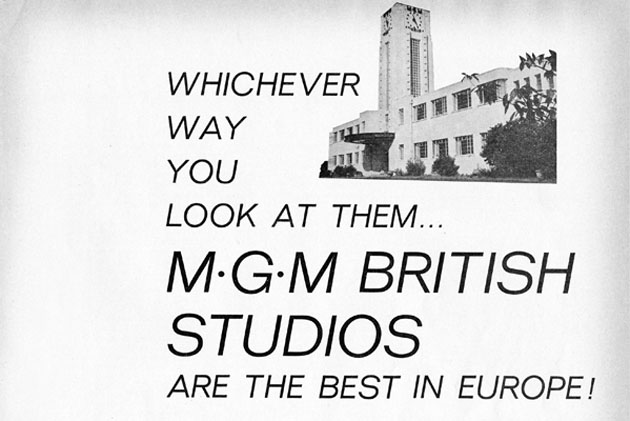
Eady Levy An Incentive
The Monopolies Report, in spite of all the fears of rumors circulated throughout the business, proved to be dull squib. While both the major circuits were not exactly white-washed as far as their monopolistic positions were concerned, the report had little positive value to suggest as an alternative to the current practice within the trade. It was clear that without ABC and Rank, who were guaranteeing the screening of a minimum number of British-made films, there would be yet further decline in British production. The industry had become so closely integrated during the past few years that to remove one of its basic elements could easily bring down the entire foundation of filmmaking in this country. That is why both ABC and the Rank group could not have the rule in the business drastically changed. With the film production becoming a closer international operation and with Britain providing in Eady levy, as an incentive for producers to make films over, then Hollywood, naturally, had every reason to increase its filmmaking activities in the United Kingdom. At the same time, only large circuits like ABC and Rank could guarantee the sort of prices and provide the financial potential to secure big box office grosses for the best films. Failure to understand the essence of the trading situation over here could only lead to disappointment and frustration by those opponents of so-called “Hollywood domination.”
Building Interest in Movie-Going
The British industry also developed a big new excitement for trade relations through the setting up of the UPTAKE campaign to foster more interest in film-going among the public. Like the old “Back to the Movies” campaign in the early 50s, this was a united effort of exhibitors, producers and renters to promote the film business. But, unlike the latter effort, it showed a surprising sense of progress throughout the year. It was also unique in that the provincial groupings within the trade appeared to demonstrate as much enthusiasm for the drive as the sophisticated Wardour Street denizens.
1966 was a great year for the box office smash hit. The list of good pictures seemed endless; “Alfie,” “Thunderball,” “A Suitable Case for Treatment,” “One Million Years B.C.,” “The Spy Who Came in From the Cold,” “The Ipcress File,” “The Blue Max,” “The Heroes of Telemark,” “Help,” and “Khartoum.” All were British made pictures financed by Hollywood, but directed in the main by British technicians and starring the best thespians that money could afford from this country.
The auspices for the future looks equally propitious. Coming from Rank and Paramount are “The Big Duel,” directed by Ken Annakin, starring Yul Brynner and Trevor Howard; Universal-International had “Deadlier than the Male,” with Richard Johnson and Elke Sommer, directed by Ralph Thomas; Universal-International also has “Charlie Bubbles,” with Albert Finney and Lisa Minnelli; “Privilege,” directed by Peter Watkins, with Paul Jones and Jean Shrimpton.
Columbia has “Casino Royale,” directed by six leading directors with Peter Sellers and David Niven, plus a host of leading international stars playing bit parts; Herman Cohen’s “Circus of Horrors,” with Joan Crawford and Ty Hardin; “The Deadly Affair,” a Sidney Lumet picture, with James Mason, Simone Signoret and Maximilian Schell; “A Man for All Seasons,” Fred Zinnemann’s terrific production of the Robert Bolt play with Paul Scofield and the Sam Spiegel/Anatole Litvak production of “The Night of the Generals,” with Peter O’Toole and Omar Sharif; “To Sir With Love,” directed by James Clavell, starring Sidney Poitier.
Good Picture List Seems Endless
From United Artists there are Bryan Forbes’ “The Whisperers,” with Eric Portman and Edith Evans; and Albert R. Broccoli and Harry Saltzman, Eon Production, of the James Bond film “You Only Live Twice,” directed by Lewis Gilbert.
Paramount offers “The Spy with a Cold Nose,” starring Lawrence Harvey and Lionel Jeffries directed by Daniel Petrie; “Half a Sixpence,” the George Sidney production with Tommy Steele and Julie Foster; “Funeral in Berlin,” the Harry Saltzman production, with Michael Caine directed by Guy Hamilton.
From 20th Century Fox “Two for the Road,” directed by Stanley Donen, with Albert Finney and Audrey Hepburn. From American International Pictures, “Jules Verne’s Rocket to the Moon,” directed by Don Sharp, with Burl Ives and Troy Donahue; from Warner’s “The Naked Runner,” directed by Sidney Furie with Frank Sinatra; “The Double Man,” with Yul Brynner and Britt Ekland, directed by Franklin Schaffner; “Fugitive in Vienna,” directed by Jack Smight starring Ingrid Bergman.
And from MGM there is “Grand Prix,” the John Frankenheimer film with James Garner and Ives Montand; “2001–A Space Odyssey,” the Stanley Kubrick science spectacular; “The Dirty Dozen,” the Robert Aldrich picture with Lee Marvin and Ernest Borgnine, and “Far From the Madding Crowd,” with Julie Christie and Alan Bates, directed by John Schlesinger.
Basis Is Assurance for Future
These films have all been made in the United Kingdom or, at least qualify for British quota and Eady levy. They are part of the ever-increasing contribution that Hollywood, in association with the British film industry, is making towards increasing the popularity of motion pictures throughout the world.
As long as this state of affairs continues in 1967, no exhibitor in Britain or America need worry about the quality of the forthcoming feature films that he can expect to play in the months and even years ahead.
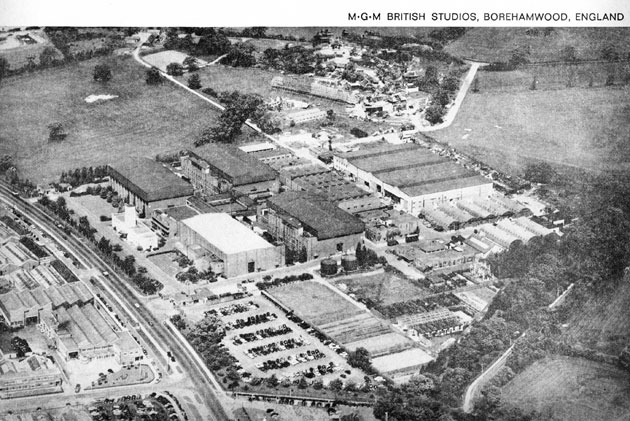
National Theatres “Institutional” Campaign Sells Fun of “Going Out to the Movies”
Motion Picture Herald. June 24, 1961
National Theatres “Institutional” Campaign Sells Fun of “Going Out to the Movies”
An exciting new “Institutional” advertising campaign, revolutionary in concept and approach and designed to “hard-sell” going to the movies, has been launched by National Theatres. The campaign, which uses as a theme — “Something WONDERFUL…Is About to Happen!” — is to be conducted over a 13-week period. The aim is to emphasize the fun, the color and excitement of “going out to the movies.”
First city to put the campaign into action is San Diego, California, with the theatres working in cooperation with the San Diego Union and Evening Tribune.
In commenting on the San Diego promotion, Pacific coast division manager William Thedford said the campaign is not expected to stimulate immediate box office sales in the manner that a direct sell on individual attractions do.
“It’s purpose is to help make the public more conscious of our theatres, to cultivate a favorable impression in their minds when they think about going out to the movies, and to make them more receptive to our direct picture-selling advertising.”
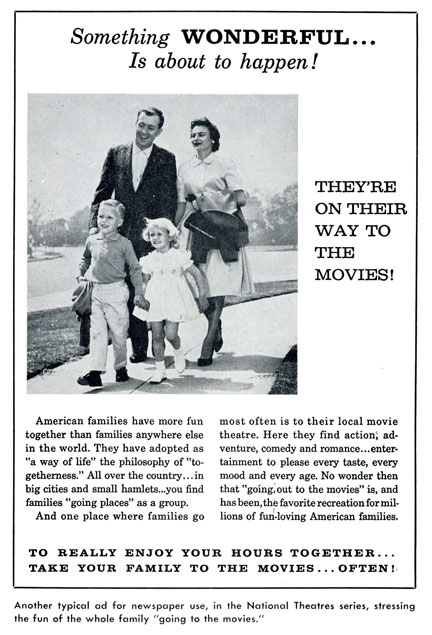
“This is a function that has been neglected, and in many cases completely ignored, for a good many years, We feel the time is right to engage in a massive campaign to let the public know that the theatres are still very much alive, still very much a part of the nation’s entertainment activities.
“While there have been certain noteworthy attempts to “institutionalize” our industry with brief slogans, we have not had a real concerned campaign to do this job with solid selling copy and art. This is such a campaign and we feel the long term benefits, both to our theatres and to the industry, can be valuable.”
Met Newspaper Executives
To activate the campaign, district manager Ernie Strum met with top executives of the Union and the Evening Tribune. He pointed out to them that theatre business is good and getting better, that the theatres are solid advertisers, week in and week out, the year round. He emphasized that the theatres will remain good advertisers as long as their business remains vital and healthy. And one way the newspapers can help to insure that vitality is to keep their readers interested “in going to the movies.”
The San Diego “plan of execution” is one that can be followed in nearly every town in which the theatre men have good relations with their newspapers. Here is the way it is working:
The theatres supply the ads and mats, ranging in size from approximately 30 to 40 inches each. One a week, for 13 weeks, the newspapers will run an ad, pointing up the fun color and excitement of “going out to the movies.” In exchange for the newspapers running the ads, the theatres will run 30- to 40-second promotional trailer for the newspapers. The trailers carry copy on various features, columnists, services, etc., available in the Union and the Evening Tribune. (In San Diego, both the morning and afternoon papers are published by the same company). The trailers are prepared and paid for by the newspapers. The trailers, run by Fox West Coast Theatres (an NT Division) as well by other houses which are participating in the project, will run for 13 weeks. In other words, the theatres are “trading” screen time for newspapers space, and doing it on a promotional basis.
Ads are run off the amusement pages — on women’s pages, sports pages, in the news sections, etc., to reach readers who may not be regular movie-goers. The ads are bright and clean, utilizing big art and lots of white space, to command maximum attention and reader interest.
“We have laid out the campaign to run over a 13-week period”, Mr Thedford said, “because we realize this kind of selling cannot penetrate in one or two or three weeks. We are attempting to formulate, and perhaps to change, a basic attitude toward motion picture theatres in the minds of large numbers of people. This can’t be done overnight. But we think it can be accomplished and we feel that 13 weeks should be long enough to make an impact.”
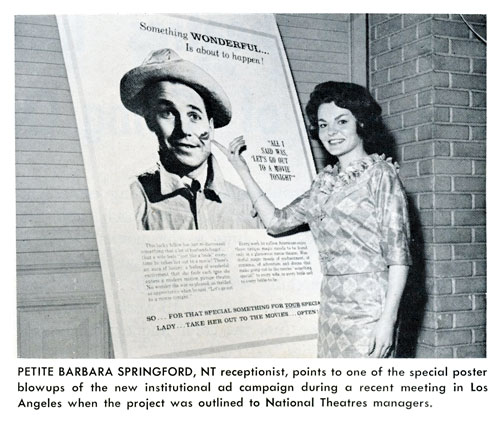
The San Diego campaign was originally set up as a “test” run in National Theatres’ Pacific Coast Division. But enthusiasm for the finished ads was so high among top NT executives and managers in the field that the company is now moving to set the campaign in towns and cities throughout the large circuit. Mr. Sturm reports the reaction to the first ads, which began last month was excellent. “We’ve been getting unusually favorable comments from patrons, friends, the newspaper people, business associates and people in the motion picture industry.”
The campaign was conceived and created by Paul Lyday of the NT advertising department and the ads were designed by Cinema Arts in Hollywood.
“We are approaching that period of the year in which the public’s interest in television reaches the low ebb and interest in ‘going out to the movies’ hits the high point,” Mr. Thedford said. “It seems that is the right time to make an all-out effort to resell the public on our theatres. And we think alert exhibitors in all parts of the country well be eager to avail themselves of this campaign.
”It can be good for their theatres individually, and good for exhibition as a whole.”
A complete set of the nine ad mats (four of which will run twice a week in the 13-week campaign) and glossy proofs may be ordered from Metropolitian Mat Service, 303 East Fourth Street, Los Angeles. The cost for the set is $10 and checks should accompany orders, National Theatres advises.
British Cinema of The 1950s:
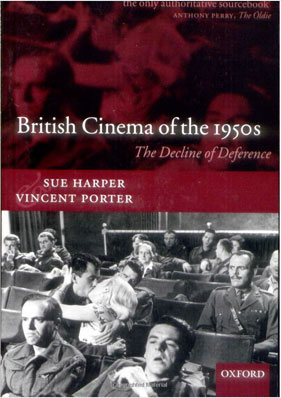
The Decline of Deference
by Sue Harper, Vincent Porter
Oxford University Press, Dec 15, 2007 – Performing Arts – 420 pages
In this definitive and long-awaited history of 1950s British cinema, Sue Harper and Vincent Porter draw extensively on previously unknown archive material to chart the growing rejection of post-war deference by both film-makers and cinema audiences. Competition from television and successive changes in government policy all forced the production industry to become more market-sensitive.
The films produced by Rank and Ealing, many of which harked back to wartime structures of feeling, were challenged by those backed by Anglo-Amalgamated and Hammer. The latter knew how to address the rebellious feelings and growing sexual discontents of a new generation of consumers.
Even the British Board of Film Censors had to adopt a more liberal attitude. The collapse of the studio system also meant that the screenwriters and the art directors had to cede creative control to a new generation of independent producers and film directors. Harper and Porter explore the effects of these social, cultural, industrial, and economic changes on 1950s British cinema.
This book is available on Amazon.com
